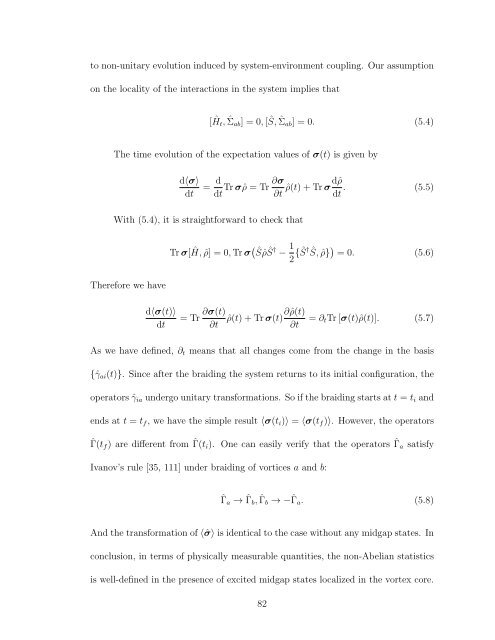ABSTRACT - DRUM - University of Maryland
ABSTRACT - DRUM - University of Maryland
ABSTRACT - DRUM - University of Maryland
Create successful ePaper yourself
Turn your PDF publications into a flip-book with our unique Google optimized e-Paper software.
to non-unitary evolution induced by system-environment coupling. Our assumption<br />
on the locality <strong>of</strong> the interactions in the system implies that<br />
[Ĥt, ˆΣ ab ] = 0, [Ŝ, ˆΣ ab ] = 0. (5.4)<br />
The time evolution <strong>of</strong> the expectation values <strong>of</strong> σ(t) is given by<br />
d〈σ〉<br />
dt<br />
= d ∂σ dˆρ<br />
Tr σ ˆρ = Tr ˆρ(t) + Tr σ<br />
dt ∂t dt . (5.5)<br />
With (5.4), it is straightforward to check that<br />
Tr σ[Ĥ, ˆρ] = 0, Tr σ( Ŝ ˆρŜ† − 1 2 {Ŝ† Ŝ, ˆρ} ) = 0. (5.6)<br />
Therefore we have<br />
d〈σ(t)〉<br />
dt<br />
= Tr ∂σ(t) ˆρ(t) + Tr σ(t) ∂ ˆρ(t)<br />
∂t<br />
∂t<br />
= ∂ t Tr [σ(t)ˆρ(t)]. (5.7)<br />
As we have defined, ∂ t means that all changes come from the change in the basis<br />
{ˆγ ai (t)}. Since after the braiding the system returns to its initial configuration, the<br />
operators ˆγ ia undergo unitary transformations. So if the braiding starts at t = t i and<br />
ends at t = t f , we have the simple result 〈σ(t i )〉 = 〈σ(t f )〉. However, the operators<br />
ˆΓ(t f ) are different from ˆΓ(t i ). One can easily verify that the operators ˆΓ a satisfy<br />
Ivanov’s rule [35, 111] under braiding <strong>of</strong> vortices a and b:<br />
ˆΓ a → ˆΓ b , ˆΓ b → −ˆΓ a . (5.8)<br />
And the transformation <strong>of</strong> 〈ˆσ〉 is identical to the case without any midgap states. In<br />
conclusion, in terms <strong>of</strong> physically measurable quantities, the non-Abelian statistics<br />
is well-defined in the presence <strong>of</strong> excited midgap states localized in the vortex core.<br />
82
















